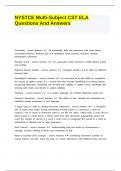Exam (elaborations)
NYSTCE Multi-Subject CST ELA Questions And Answers.
NYSTCE Multi-Subject CST ELA Questions And Answers.
NYSTCE Multi-Subject CST ELA Questions And Answers.
NYSTCE Multi-Subject CST ELA Questions And Answers.
NYSTCE Multi-Subject CST ELA Questions And Answers.
[Show more]
Preview 3 out of 24 pages
Uploaded on
August 24, 2024
Number of pages
24
Written in
2024/2025
Type
Exam (elaborations)
Contains
Questions & answers
Institution
NYSTCE
Course
NYSTCE
$11.49
Also available in package deal from $29.49
100% satisfaction guarantee
Immediately available after payment
Both online and in PDF
No strings attached
Also available in package deal (1)
1. Exam (elaborations) - Nystce cst multi subject part 1 (241) questions and answers 20232024 update!!.
2. Exam (elaborations) - Nystce cst 245 arts and science questions and answers.
3. Exam (elaborations) - Nystce 211 exam questions and answers.
4. Exam (elaborations) - Nystce cst social studies questions and answers.
5. Exam (elaborations) - Nystce educating all students (eas) exam questions and answers.
6. Exam (elaborations) - Nystce educating all students (eas) exam questions and answers.
7. Exam (elaborations) - Nystce multi-subject cst part 3, arts & sciences questions and answers.
8. Exam (elaborations) - Nystce multi-subject cst ela questions and answers.
9. Exam (elaborations) - Nystce cst multisubject part 1 (241) questions and answers.
Show more
NYSTCE Multi-Subject CST ELA




